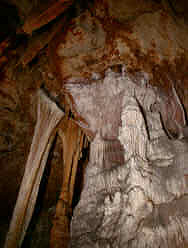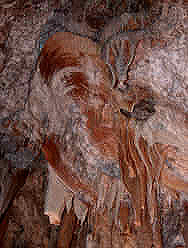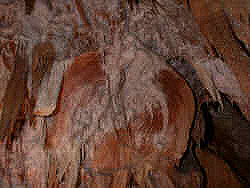Grotte de la Madeleine
Useful Information


| Location: |
Route touristique des Gorges de l’Ardèche, 07700 Saint-Remèze.
A7, exit Montélimar or Bollène, up the Ardèche valley. Located at the road D217, between Vallon Pont d’Arc and Orgnac. (44.339706, 4.483763) |
| Open: |
APR to JUN daily 10-18. JUL to AUG daily 10-19. SEP daily 10-18. OCT daily 10-17. [2023] |
| Fee: |
Adults EUR 11, Children (6-15) EUR 6.50, Children (0-5) free, Students EUR 8.80. Groups (20+): Adults EUR 6, Children (6-15) EUR 3.90. [2023] |
| Classification: |
 Karst Cave Karst Cave
|
| Light: |
 Electric Light Electric Light
 Son et Lumière Son et Lumière
|
| Dimension: | T=15 °C. |
| Guided tours: |
L=1,000 m, D=1 h, VR=65 m, St=250.


Audioguides 






|
| Photography: | allowed |
| Accessibility: | no |
| Bibliography: |
Ludovic Mocochain (2007): Les manifestations géodynamiques - externes et internes - de la crise de salinité messinienne sur une plate-forme carbonatée péri-méditerranéenne : le karst de la Basse-Ardèche (Moyenne vallée du Rhône ; France), Aix-en-Provence, 2007, 221 p.  online
online
Y. Billaud (1979): Étude de la grotte de la Madeleine, plateau de St-Remèze - 07 - Cadre général, morphologie, remplissage D.E.A., Université Lyon I, 57 p., 21 fig. 
|
| Address: |
Grotte de la Madeleine, Route touristique des Gorges de l’Ardèche, 07700 Saint-Remèze, Tel: +33-475-04-35-06.
E-mail: |
| As far as we know this information was accurate when it was published (see years in brackets), but may have changed since then. Please check rates and details directly with the companies in question if you need more recent info. |
|
History
| 1887 | discovered by a shepherd named Germain Rigaud who was searching for a lost goat. |
| 1936 | explored by
 Robert de Joly. Robert de Joly.
|
| AUG-1944 | Escure cave used as a shelter for families from the village during the retreat of German troops. |
| 1946 | explored by André Glory. |
| 1952-53 | explored by Jean Trébuchon, first survey and map. |
| 1960 | upper rooms cleared and explored by engineer P. Girodias. |
| 1967 | Route touristique des Gorges de l’Ardèche (Ardèche tourist road) completed. |
| 10-AUG-1969 | show cave opened to the public. |
Description








Grotte de la Madeleine is the only show cave, located directly at the Ardèche gorge, on the left side of the river. The cave has a parking lot on top of the plateau, at the Route touristique des Gorges de l’Ardèche (Ardèche tourist road). From here a narrow road leads down to the edge of the gorge, where the ticket office is located. Its possible to park here right above the turnaround at the end of the cul-de-sac, but the small parking lot is often full. The ticket office contains a small exhibition, and on the far side an exit which brings visitors to the trail along the rim of the vertical gorge wall. There is a trail in both directions, the trail to the right leads to an outlook and ends there. The trail to the left leads along the cliff to the entrance of the cave. From this trail, the visitor has a very nice view on the Ardèche river, 200 meters below. This is the deepest and most impressive part of the gorge, with 200 m high walls in Cretaceous limestone. Even if you do not want to visit the cave, the belvedere in front of the cave is accessible without restrictions and for free, and considered the most beautiful outlook of the gorge. Many people are canoeing down the Ardèche and visit the cave by walking up to the cave entrance.
The cave of the Madeleine is actually made up of two caves: the grotte de l’Escure (Lescure Cave) and the Grotte de la Madeleine (Madeleine Cave), one above the other. They are connected by an artificial tunnel. The upper cave, the Lescure Cave was known for many years and was used to mine phosphate. It is also known as grotte Obscure (Obscure Cave) or Caverne des ours (Bear Cave).
The Madeleine Cave is larger, and the natural entrance is only 50 meters above the river at the foot of the cliff. Located in the middle of the cliff face, this entrance was hard to reach. It was discovered in 1887 (or probably in 1888?) by a shepherd named Germain Rigaud, nicknamed le filleul (the godchild), who was searching for a lost goat. He found a candle in his pocket, so he entered the cave with only a flickering candle for illumination. This is one of those things we generally discourage because it’s far too dangerous. Its unclear how far he went in, but he obviously realized the potential of his discovery and shared his discovery with his neighbours. Obviously nobody was brave enough to explore the cave for some time.
But the locals had a legend, that there once was a Knight Templar’s hospital devoted to Saint Mary Magdalene not far from the cave entrance. And so they called the newly discovered cave Madeleine Cave and the name stuck. We don’t know whether the legend is true or whether such a hospital actually existed, but it seems unlikely, as there are no ruins or names on the maps. The names of the nearby outlooks named Belvédère les Templiers seem to be based on the same legend.
It was half a century later, when the French cavers actually started exploration.
The cavers of that era became quite famous later, the cave was actually explored by the who-is-who of French caving at that time.
 Robert de Joly
was the first to enter the cave in 1936, followed by Abbé André Glory in 1946, and Jean Trébuchon in 1952-53.
The two-year exploration by Jean Trébuchon was very meticulous, and he also carried out the first survey and drew a map.
The engineer P. Girodias continued the exploration in 1960, and he cleared and explored the upper rooms.
At this time 4 km of passages is explored and surveyed.
Robert de Joly
was the first to enter the cave in 1936, followed by Abbé André Glory in 1946, and Jean Trébuchon in 1952-53.
The two-year exploration by Jean Trébuchon was very meticulous, and he also carried out the first survey and drew a map.
The engineer P. Girodias continued the exploration in 1960, and he cleared and explored the upper rooms.
At this time 4 km of passages is explored and surveyed.
The locals and tourists started to use the cave, to connect the plateau with the gorge below. In 1952, Léon Jouve started a naturist campsite at the river, and the cave of La Madeleine was the only possible access to the river. A steep stairway through the caverns was installed between the upper and lower entrance of the Grotte de la Madeleine. The caves were not connected at that time. The road which exists today, the Ardèche tourist road was built in 1967. This increased the number of visitors substantially, and encouraged the mayor of the commune of Saint-Remèze, Charles Boulle, to develop the cave. A tunnel was built between the two caves by a company from Gard, and two years later the cave was opened to the public. The cave is owned by the commune until today, but first it was operated by the Syndicat mixte d’équipement de l’Ardèche (SMEA). Since 1979 the cave is operated by the commune of Saint-Remèze under direct management.
The tour starts with the L’Escure, the first room, which contains some stalactites and stalagmites which are dry. They obviously formed during more humid times. Then the crèche (nativity scene) follows, which is notable for a statue of Germain Rigaud and his goat. The next room is called the Salle des Ossements (Ossuary), because it was filled with cave sediments which were full of bones. The remains of hyenas, deer, elk, horses were excavated. The walls show the marks of cave bears, polished spots as well as claw marks. Then the 20 m long artificial tunnel leads into the second cave.
The first chamber is called La grande salle de la grotte de la Madeleine (Great Room) or short salle du chaos (Chaos Room).
It is 50 m high, 30 m long, and full of speleothems, stalactites, stalagmites, columns, draperies, organ pipes, and gypsum flowers.
The tourist trails lead down through this chamber, staircase by staircase.
There are more columns, stalactites, and the famous disques
( Shield).
And yes, the annoying, obligatory
(subterranean audiovisual stuff) takes place here.
At least they do without coloured light.
Finally, the rimstone pools and the helictites are reached, both are quite rare in other caves, though not as rare as the shields.
However, here they are found in abundance, they cover the walls in bulbous crusts, like wire balls.
Shield).
And yes, the annoying, obligatory
(subterranean audiovisual stuff) takes place here.
At least they do without coloured light.
Finally, the rimstone pools and the helictites are reached, both are quite rare in other caves, though not as rare as the shields.
However, here they are found in abundance, they cover the walls in bulbous crusts, like wire balls.
The next chamber is the Galerie des Colonnes (Column Chamber), named for its many columns and pillars of varied sizes. And of course here are more draperies, discs, gypsum flowers, and helictites.
The last chamber was added to the tour a few years ago, and it is called the Salle du Fond (back room) which is exceptional for its calcite crystals also named
 Dogtooth Spar.
Another rare speleothem which is known from few caves in this abundance.
Dogtooth Spar.
Another rare speleothem which is known from few caves in this abundance.
This is the regular tour which takes an hour. The trail is 500 m long, and it’s an in-and-out-tour, so you have to walk 1 km and go down and back up 60 m. They offer other tours like the Children’s Tour, where Mady the goat got lost in the Madeleine cave during a rainstorm. Her owner, Germain Rigaud and the children have to find her! And there are several other tours available, with cave trekking, guided walks through the gorge, and explanations about the nature, the animals, the geology of the gorge and much more. There is even a tour with zip line. And there are tours with wine tasting. Some are offered only in French though. For details, we suggest a look at their website, they all require online reservation, and the available dates and times are in the booking system.
There is another short walk, which branches off the road to the cave, right above the parking lot. the trail leads to the Belvédère de la Madeleine, which is located downstream from the cave entrance, and offers a view on the rock formation called Rocher de la Cathédrale (Cathedral Rock).








 Search DuckDuckGo for "Grotte de la Madeleine"
Search DuckDuckGo for "Grotte de la Madeleine" Google Earth Placemark
Google Earth Placemark Grotte de la Madeleine
Grotte de la Madeleine  La Grotte de la Madeleine, official website.
La Grotte de la Madeleine, official website. Index
Index Topics
Topics Hierarchical
Hierarchical Countries
Countries Maps
Maps